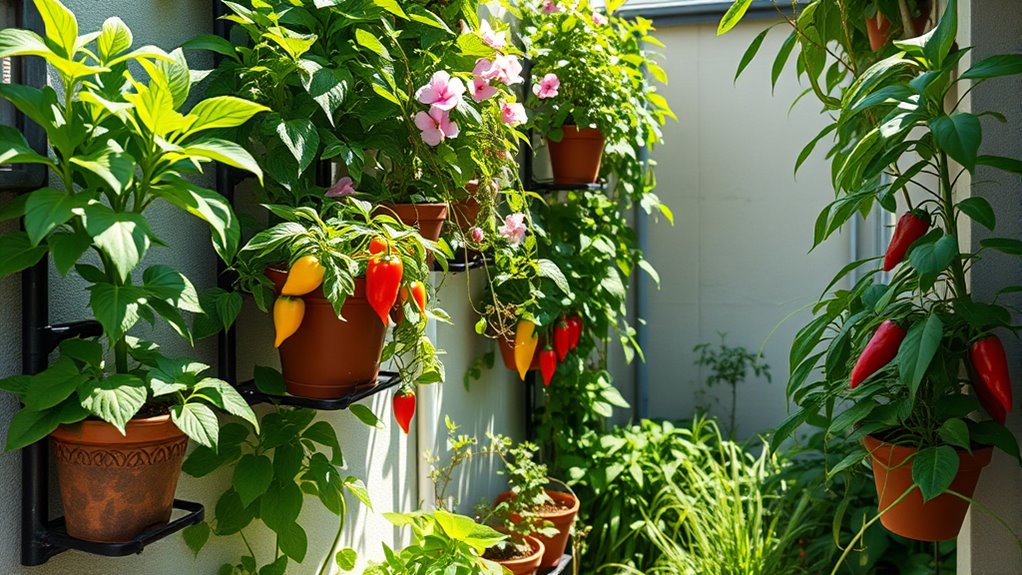To maximize yield in small garden spaces, try vertical gardening by stacking plants on walls, fences, or custom structures. Use companion planting to boost growth and naturally repel pests, like planting marigolds with vegetables. Good airflow and easy pest detection help keep plants healthy. Incorporate natural pest-repelling plants and regularly inspect for issues. Keep exploring these strategies to unbolt even more ideas for efficient small-space gardening success.
Key Takeaways
- Use vertical structures like wall planters and trellises to maximize planting area in limited spaces.
- Incorporate companion planting to enhance growth, pest control, and crop yield in vertical setups.
- Select pest-repelling plants such as marigolds to naturally deter pests and protect your crops.
- Ensure good air circulation around plants to reduce disease risk and promote healthy growth.
- Regularly monitor and maintain plants for early pest detection and optimal productivity.

Vertical gardening offers an innovative way to maximize space and create lush, green environments even in small areas. When you’re working with limited ground space, vertical setups allow you to grow more plants without sacrificing your yard’s aesthetic appeal. By stacking or arranging plants vertically, you can make the most of walls, fences, or specially designed structures. This approach not only conserves space but also creates a vibrant, layered garden that’s both functional and beautiful.
Maximize small spaces with vertical gardening for a lush, layered, and beautiful environment.
One key advantage of vertical gardening is the ability to incorporate companion planting into your design. Companion planting involves pairing specific plants that benefit each other, whether by improving growth, flavor, or pest resistance. For example, planting basil near tomatoes can enhance flavor and deter pests like aphids. Similarly, marigolds placed among vegetables can help repel nematodes and other harmful insects. When you arrange your plants vertically, it’s easier to implement these beneficial pairings in close proximity, maximizing their mutual advantages. It also makes it simpler to observe plant health and manage their needs, leading to healthier, more productive crops.
Pest control becomes more manageable with vertical gardening because it allows you to keep a close eye on your plants. When plants are grown on walls or vertical structures, you can inspect them regularly for signs of pests or disease. This heightened visibility helps you catch problems early before they spread. Additionally, vertical gardens reduce some pest issues related to soil-borne insects and fungi, especially if you use containers with good drainage and sterilized soil. You can also incorporate natural pest-repelling plants directly into your vertical setup, creating a living barrier that deters pests without resorting to chemicals. This natural approach aligns perfectly with the concept of companion planting, turning your vertical garden into a resilient ecosystem that supports plant health and reduces the need for interventions.
Another benefit of vertical gardening is that it facilitates better air circulation around your plants. Good airflow helps prevent fungal diseases and makes it more difficult for pests to settle. Plus, the proximity of plants in a vertical setup encourages beneficial insect activity, like pollinators and predatory insects that keep pest populations in check. By carefully choosing plant combinations based on companion planting principles, you can create a balanced environment that naturally suppresses pests. Additionally, educating yourself about the principles of amazing life together] can inspire more effective and sustainable gardening techniques that promote long-term plant health.
Frequently Asked Questions
What Are the Best Plants for Vertical Gardening in Small Spaces?
You can boost your vertical garden’s success by choosing plants like strawberries, herbs, and leafy greens, which thrive in small spaces. Companion planting helps improve growth and ward off pests, so consider pairing basil with tomatoes or marigolds with beans. Seasonal planning is key; plant accordingly so your garden remains productive year-round. Use vertical space wisely, ensuring good airflow and sunlight to maximize your garden’s yield.
How Do I Prevent Pests in Vertical Gardens?
Oh, the joy of battling pests in your vertical paradise! To prevent them, you should embrace companion planting—think basil with tomatoes—and use natural pest control methods. Regularly inspect your plants, encourage beneficial insects like ladybugs, and avoid chemical pesticides that turn your garden into a toxic buffet. With these tips, you’ll keep pests at bay while nurturing a thriving, eco-friendly vertical garden.
What Are the Watering Requirements for Vertical Gardens?
You need to understand the watering requirements for your vertical garden to keep plants healthy. Use drip irrigation for consistent moisture, ensuring water reaches all levels evenly. Water your plants regularly, but avoid overwatering—generally, watering frequency should be every couple of days, depending on weather and plant type. Monitor soil moisture and adjust your drip system accordingly to prevent root rot and promote ideal growth.
How Can I Improve Drainage in Vertical Gardening Setups?
When it comes to improving drainage in your vertical garden, you need to think outside the box. You can start by adding soil amendments that enhance permeability and incorporating drainage layers like gravel or broken pottery at the bottom of your containers. These steps help prevent waterlogging, giving your plants a healthy environment to thrive. Remember, a well-drained setup keeps your garden happy and fruitful, no matter how small the space.
What Materials Are Safest for Building Vertical Garden Structures?
When building your vertical garden, choose safe, sustainable materials that support healthy plant growth. Opt for DIY construction using untreated wood, recycled pallets, or bamboo, which are eco-friendly and non-toxic. Avoid treated wood or plastics with harmful chemicals. Using these sustainable materials guarantees your garden stays safe for plants and your family, while also reducing environmental impact. Your DIY approach makes it easy to create a sturdy, eco-conscious vertical garden structure.
Conclusion
By embracing vertical gardening, you turn your small space into a lush, vibrant oasis. Imagine lush green leaves spilling over your walls, colorful blooms dancing in the breeze, and fresh herbs glistening in the sunlight. As you tend to your plants, you’ll see your garden grow upward and outward, transforming even the tiniest nook into a bountiful paradise. With a little care, your compact garden will burst with life, beauty, and harvests that make every inch worthwhile.










